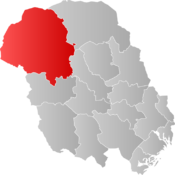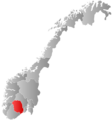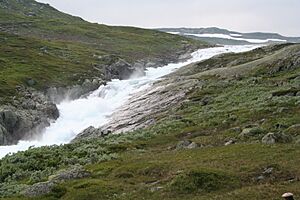Vinje facts for kids
Quick facts for kids
Vinje kommune
|
|||
|---|---|---|---|
|
Municipality
|
|||
 |
|||
|
|||

Vinje within Telemark
|
|||
| Country | Norway | ||
| County | Telemark | ||
| District | Vest-Telemark | ||
| Established | 1 Jan 1838 | ||
| Administrative centre | Åmot | ||
| Area | |||
| • Total | 3,105.83 km2 (1,199.17 sq mi) | ||
| • Land | 2,724.86 km2 (1,052.07 sq mi) | ||
| • Water | 380.98 km2 (147.10 sq mi) 12.3% | ||
| Area rank | #14 in Norway | ||
| Population
(2023)
|
|||
| • Total | 3,832 | ||
| • Rank | #209 in Norway | ||
| • Density | 1.4/km2 (4/sq mi) | ||
| • Change (10 years) | 3% | ||
| Demonym(s) | Vinbygg Vinbygge (male) Vinbyggje (female) |
||
| Time zone | UTC+01:00 (CET) | ||
| • Summer (DST) | UTC+02:00 (CEST) | ||
| ISO 3166 code | NO-4036 | ||
| Official language form | Nynorsk | ||
| Created as | Formannskapsdistrikt in 1838 | ||
|
|
|||
Vinje is a municipality located in Telemark county, Norway. It is part of the traditional district of Vest-Telemark. The main town and administrative centre of Vinje is Åmot.
Other villages in the municipality include Arabygdi, Edland, Grunge, Haukeli, Krossen, Møsstrond, Nesland, Øyfjell, Raulandsgrend, and Vinje.
Vinje covers about 3,106 square kilometers. This makes it the 14th largest municipality in Norway by area. With a population of 3,832 people, Vinje is the 209th most populated municipality. The number of people living here has grown by 3% in the last ten years.
Contents
About Vinje: History and Symbols
How Vinje Municipality Was Formed
The area of Vinje became a municipality on January 1, 1838. This happened because of a law called formannskapsdistrikt.
Later, in 1860, a northern part of Vinje and an area from Lårdal joined together. They formed a new municipality called Rauland.
In the 1960s, many municipalities in Norway merged. On January 1, 1964, Rauland and Vinje municipalities combined. This created the larger Vinje municipality we know today.
What Does the Name Vinje Mean?
The name "Vinje" comes from an old farm called Vinjar. The first Vinje Church was built there.
The name Vinjar is a plural form of the Old Norse word vin. This word means "meadow" or "pasture." So, the name Vinje is linked to green fields and grazing lands.
The Coat of Arms: A Blue Goat
Vinje's coat of arms was approved on November 16, 1990. It shows a silver (white) billy goat on a blue background.
The blue color and the goat were chosen because of a poem. It was written by Aasmund Olavsson Vinje, a famous poet from the area. His poem, called Blåmann (meaning "blue man"), is about a goat.
The goat also represents how important goat farming and sheep farming are in this mountainous region. The coat of arms was designed by Arvid Sveen. The municipal flag looks just like the coat of arms.
Churches in Vinje
The Church of Norway has four parishes (local church areas) in Vinje. These churches are part of the Øvre Telemark prosti (a larger church district) in the Diocese of Agder og Telemark.
| Parish (sokn) | Church name | Location of the church | Year built |
|---|---|---|---|
| Grungedal | Grunge Church | Grunge | 1850 |
| Rauland | Møsstrond Church | Møsstrond | 1923 |
| Rauland Church | Raulandsgrend | 1803 | |
| Vinje og Nesland | Nesland Church | Nesland | 1847 |
| Vinje Church | Vinje | 1796 | |
| Øyfjell | Øyfjell Church | Øyfjell | 1833 |
Vinje's Rich History and Culture
Vinje has a long history of arts and crafts. These traditions are still very strong today. Rauland is home to a national academy. This school teaches arts, crafts, and traditional music.
Folk music has always been important in Vinje. The famous folk musician Myllarguten, whose real name was Targjei Augundsson, spent his last years in Rauland. Vinje has also been home to many artists who create rosemåling, a traditional Norwegian decorative painting style.
During World War II, Vinje was a site of important battles. At the Battle of Vinjesvingen, Norwegian forces bravely fought against stronger German forces for over a month.
Exploring Vinje's Geography and Nature
Vinje is located on both the Hardangervidda plateau and parts of the Setesdalsheiene mountain plateau. Most of the land in the municipality is at a high elevation.
The European route E134 highway goes through Vinje. This road crosses a mountain pass, connecting Eastern Norway and Western Norway. Vinje is about halfway between Oslo (in the east) and Haugesund (on Norway's west coast).
From Haukeli, the Norwegian National Road 9 goes up steep slopes to Hovden. It then continues south through the Setesdal valley to the city of Kristiansand on the southern coast.
Outdoor Activities and Natural Wonders
The mountain ski resort Haukelifjell is also nearby. This area is known for its rugged, mountainous landscape. It's a great place for many outdoor activities. You can enjoy hiking, mountain biking, snowboarding, skiing, fishing, and canoeing.
Part of the Hardangervidda National Park is in western Vinje. The village of Arabygdi sits on Totak lake. A famous sight there is the "Urdbøuri." This is the largest stone scree (a pile of broken rocks) in Northern Europe. It has huge boulders scattered across the valley floor.
The rivers Tokke and Vinjeåi both flow through Vinje. Several lakes are also found here, including Holmavatnet, Møsvatn, Songavatnet, Totak, and Vinjevatn. The mountains Fitjanuten, Kistenuten, and Vassdalseggi are all located on the border of the municipality and county in western Vinje.
Notable People from Vinje
Vinje has been home to many talented people in the arts, public service, and sports.
The Arts
- Sveinung Svalastoga (1772–1809): A painter, poet, and woodcarver known for rosemåling.
- Myllarguten (1801–1872): A famous folk musician and master fiddler.
- Aasmund Olavsson Vinje (1818–1870): A well-known poet and journalist who wrote in Nynorsk.
- Rikard Berge (1881–1969): A folklorist, museum expert, and writer.
- Tarjei Vesaas (1897–1970): A respected poet and novelist.
- Aslaug Vaa (1889–1965): A poet and playwright.
- Aslak Brekke (1901–1978): A vocalist known for stev (a type of folk song).
- Dyre Vaa (1903–1980): A sculptor and painter whose works are in Oslo and Vinje.
- Anne Lofthus (1932–2003): A ceramic artist and art teacher.
- Guri Vesaas (born 1939): A writer and translator of children's books.
- Stein Versto (born 1957): A poet, novelist, translator, and folk musician.
- Aasmund Nordstoga (born 1964): A musician, singer, composer, and TV presenter.
- Sven Erik Kristiansen (born 1969): A musician and former vocalist.
- Arve Moen Bergset (born 1972): A traditional folk singer, hardanger fiddler, and classical violinist.
- Odd Nordstoga (born 1972): A folk singer, musician, actor, and editor.
- Ingebjørg Bratland (born 1990): A folk singer and artist.
Public Service
- Paul Peterson Paus (1625–1682): A cleric, political activist, and poet.
- Olav Aslakson Versto (1892–1977): A politician.
- Einar Skinnarland (1918–2002): A Norwegian resistance fighter during WWII.
- Aslak Versto (1924–1992): A politician.
- Olav Vesaas (born 1935): A journalist, biographer, and publisher.
- Olav Versto (1950–2011): A journalist and editor.
- Astrid Versto (born 1953): A journalist and diplomat.
Sport
- Olav Jenssen (born 1962): A discus thrower who competed in the 1992 Summer Olympics.
- Knut Tore Apeland (born 1968): A former Nordic combined skier and two-time Olympic silver medallist.
- Terje Håkonsen (born 1974): A famous snowboarder.
Attractions to Visit in Vinje
- The home of Myllarguten is now a small museum. It is located at Kosi in Arabygdi.
- You can also see the monument of Myllarguten. He was a 19th-century musician who played for kings and inspired the famous composer Edvard Grieg. The monument is on the roadside, across from Kosi.
Images for kids
See also
 In Spanish: Vinje para niños
In Spanish: Vinje para niños







